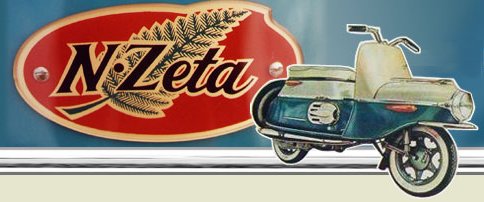In 1961 an Auckland company, JNZ Manufacturing Ltd, after acquiring an import license, began importing Cezeta scooters which they then assembled here with local content under the name ‘NZeta’. The Cezeta was made by the Ceske Zavody Motocyklove Company of Czechoslovakia where the motorcycle industry was ahead of the world at that time.
The managing director was a man called Lorenz Von Sommeruga more famously known as Laurie Summers. Parts were sent by rail from Prague to Hamburg, then shipped to NZ where the scooter was assembled at the 22 England St, Ponsonby, plant. Another local company, VW Motors, assembled and welded the bodies as sub-contractors.

The point of New Zealand production was that high import duties were placed on imported motor vehicles. New Zealand assembly reduced the imported cost and hence the duty plus the New Zealand manufacture of components further reduced the duty. JNZ (Jawa New Zealand) had to produce a scooter with an excess of 25% local content in the first 2 years. This was made up of not only labour, paint and tyres. Mufflers, exhausts and handlebars were made in conjunction with NZ Steel and Tube and quality chrome plating of all parts including the fuel tank was carried out locally in Otahuhu.
The NZeta 501 was based on the Jawa Cezeta model 501/05. It was fitted with a dynastarter plus kick start and 2 batteries giving 12 volts. The dynastarter worked as a generator and a starter motor. Ignition was electrical, the stator then switched by a voltage regulator to become the generator and charge the battery. One of the features of this model was where the 2 batteries were located at the front of the scooter, a design change implemented by JNZ. There were 2 models after the 501/05, the first with minor refinements and the second was the 502/00 L or “Supreme”.
The NZeta 502 was based on the Jawa Cezeta model 502/00. It was fitted with a dynastarter only and also had 2 batteries giving 12 volts. The dynastarter worked as a generator and a starter motor. Ignition was electrical, the stator then switched by a voltage regulator to become the generator and charge the battery. Some models had accessory kick starts that could be used when required.
The 501 model is identified visually by a center skirt horn and dual exhausts plus they have vents on the rear panels and a center stand. The 502 model is identified visually by no center skirt horn, a single exhaust and usually came with a side stand. Most mechanical parts were common with Jawa/CZs motorcycle range, except for the frame and wheels.
At the height of the operation staff numbers were approximately 35 and 1500 scooters were manufactured in the first year and sent to dealers as far away as Dunedin. With a price of 219 pounds they were popular with local markets as an alternative to the biggest competitor at that time, Vespa. The total number of NZeta’s produced was about 4000 scooters.
Also at that time, other scooters like the Rabbits, Vespas and Triumph Tigress were being imported and partly manufactured here as well. Some importers were being favored over JNZ (who then went on to win the first ever case to the ombudsman) then with the emergence of the Japanese motorcycling industry here, the writing was on the wall and unfortunately JNZ went downhill. Its closure was a commercial tragedy.
Production ceased in 1963, and today these machines are sought after by collectors. The company failed to survive due to a lack of demand for their scooters at the time.
